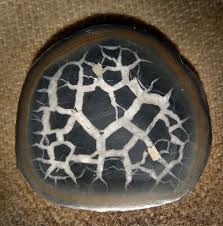Septarian Nodules
Septarian concretions or septarian nodules are
concretions containing angular cavities or cracks, which are called "septaria".
This word comes from the Latin word septum; meaning “partition", and
refers to the cracks or separations in this kind of rock. Septarians formed somewhere
between 50 to 70 million years ago as a result of volcanic eruptions. Dead sea
life was then chemically attracted to the sediment around them, forming mud
balls. As the oceans receded, the balls dried and cracked. Due to their
bentonite content they also shrank in size, creating the cracks inside. As
decomposed shells seeped down into the cracks in the mud balls, calcite
crystals formed. The outer thin walls of calcite then transformed into
aragonite. Septarians are composed of Calcite (the yellow centers), Aragonite (the
brown lines), and the outer grey rock is Limestone. Septarians can be found all
over the world in many different locations.





